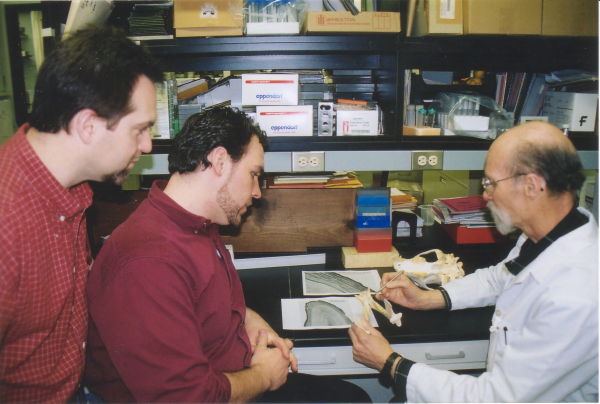“MOTHER NATURE’S BEAR ESSENTIALS… Could key Space Flight, Medical Advances Too”
By Dick Ellis
 By his very nature, Professor Danny Riley, Ph.D. with the Department of Cell Biology, Neurobiology and Anatomy at the Medical College of Wisconsin, is a skeptic. Throughout his life he has been a questioner in search of more proof, and more answers.
By his very nature, Professor Danny Riley, Ph.D. with the Department of Cell Biology, Neurobiology and Anatomy at the Medical College of Wisconsin, is a skeptic. Throughout his life he has been a questioner in search of more proof, and more answers.
One takes note of Riley’s cautious optimism, then, that research in the bear dens of Wisconsin seeking answers on muscle atrophy may not only benefit the NASA space program. But learning Mother Nature’s secrets of the wintering bear could also stimulate extraordinary medical advances in a multitude of diseases affecting millions of people.
Since 1978, Riley has worked on NASA space flight experiments and trained astronauts to conduct experiments on muscle atrophy in space. Humans, he said, experience muscle break-down even after short periods in the gravity-free environment of space, particularly within the “slow”weight-bearing muscles.
Muscle atrophy experienced by astronauts and by bedridden patients, each of whom has temporarily stopped using weight-bearing muscles, is almost identical. Ask an astronaut returning from a week in space or a patient bed-ridden for a week to walk again and each would experience similar difficulty.
A medical miracle from a human perspective, black bears in a hibernation-like state for four or five months apparently suffer little muscle atrophy. If compelled to exit the den after months in slumber, in fact, the bear could be on the move instantly as if never down.
Currently, nearly half of Wisconsin sows in dens are also rearing up to four constantly-nursing cubs. The adults maintain their own excellent health, and the health of their newborns, somehow accomplishing this by bypassing the kidney and without eating, drinking, urinating or defecating for four or five months.
After determining that it was feasible to safely work with immobilized bears in a cold, exterior environment of Wisconsin, Riley began last winter to do tissue analysis for muscle atrophy on the bear’s serratus anterior muscle with Naturalist Val Vogel of Wildlife-Re-Creations. The serratus anterior is a weight-bearing walking muscle and also accessory to the bear’s breathing during intense physical activity.
Riley and Vogel also began to take muscle and fat tissue and blood samples from denned bears in summer, and recapturing the same radio-collared animals in winter for comparison with additional samples. With eight animals sampled to date, the ultimate goal is to understand why bears suffer comparatively minimal muscle atrophy despite its extended state of inactivity. And how the animal can maintain its health and the health of offspring without performing the normal, daily bodily functions of any other mammal.
For example, Riley said, a 150 pound bear will put on 50 pounds of fat prior to wintering. Before he emerges from the den in spring, the bear may have lost 40 pounds of fat but suffered no muscle atrophy.
“It appears that the fat has to reach a certain thickness before the bear hibernates,” Riley said. “Our hypothesis is that perhaps a protein, lipid or steroid hormone made by or processed in the fat is the likely source maintaining the muscles. The capacity to produce the hormone increases as the fat builds up and the bear hibernates. In spring the hormone is used up, the bear comes out of hibernation. But what’s in the fat? It’s different in the summer and winter as far as hormones.”
Riley is comparing the size of the muscle cells of the same bears in summer and winter, and muscle tissue from astronauts that returned from the space station will also be compared with bears for muscle atrophy. “We’ll see who won,” Riley said with a smile. “In 17 days in space astronauts have experienced 20 percent muscle atrophy. Bears in hibernation five to six months might only have 20 percent atrophy.”
He raises the possibility of whether the bear’s ability to get up and run immediately after extended slumber might be related to the animal’s complete absence of eating and dramatic weight loss during hibernation. “But,” he said, “to preserve muscle fiber size for four months is amazing.”
Although his primary interest lies in muscle atrophy, Riley called study of the bear fascinating and offered numerous, compelling motivators for continued research on the animal related to the enormous potential for biomedical advances; beginning with the fact that the bear also reportedly suffers no bone mass loss during hibernation.
With 60 percent of American adults overweight and at risk for cardiovascular disease and diabetes, the entire issue of fat, he said, is also relevant to ongoing research.Wintering bears, he said, have not only added an abundance of fat, the animal’s cholesterol level climbs to two to three times its summer level. Still, it suffers no vascular disease. The bear prepares for wintering seemingly by overcoming a command of the central nervous system to “stop eating” issued in the release of the protein, leptin from growing fat cells, Riley said.
“The other issue related to eating is anorexia,” he said. “During hibernation the bear is anorexic. It doesn’t eat until spring. What makes it stop and start eating? An uncontrollable urge to eat was recently linked in obese humans to excessive ghrelin hormone secretion from the stomach.”
Also, post-surgical patients bed-ridden for extended periods are susceptible to thrombosis, blood clots forming in deep veins that can trigger heart attacks or strokes. “Is there something in the bear that we can imitate after surgery?” he asked. “Our study is different because we’re trying to look at the whole organism to find answers.”
Answers that could help change our world, and the world above us. Just ask a man born to ask questions. “We can’t just say that the bear gets up and walks away after hibernating,” he said. “We need to know why it’s able to do that if we want to help human medicine and veterinary medicine. The bear is an organism that has the very high potential to give us new information. That’s why I’m pursuing this.”
Currently, research in the bear dens of Wisconsin is in its infancy and privately funded without a NASA grant. With hard data, Riley expects to be able to approach
NASA, identify how the bear accomplishes the miraculous feat of minimal muscle atrophy, and eventually, apply the secret to the astronauts during future space flights.
“This year has very well demonstrated the feasibility of studying this organism for its biomedical value,” Riley said. “If we stay on schedule we can expect to put in for a grant from NASA in about a year from now.”
Editor’s Note: This Story was written in 2003. A story updating the progress of black bear research will be posted in the near future.









